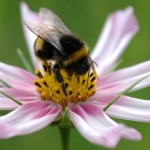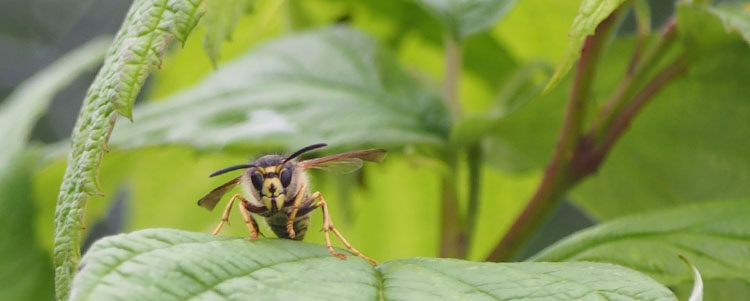Wasps and Bees
Most of the 20,000 species of wasps are solitary, but because solitary wasps do not sting, most humans are more familiar with social wasps, who live in complex communities, than their solitary cousins. Though very few social wasps, such as paper wasps, mud daubers, yellow jackets, hornets, and umbrella wasps, create homes near human dwellings, all wasps play vital roles in ecosystems.
Wasps are classified in the same insect order (Hymenoptera) as bees, so it’s not surprising that people often mistake common wasps like yellow jackets, who have fuzzy yellow and black-striped bodies, for bees.
Wasps are the pinnacle of animal architects. They construct hanging nests (hives) from structures or build subterranean combs or ground nests. When wasps build hives, they don’t re-use them from year to year, because they disintegrate over the winter. Ground nests, on the other hand, are extremely durable.
Yellow jackets are social wasps and generally nest in the ground, but they will occasionally nest in hollow logs and cinderblock fences. Their nests are made into thousands of cells from masticated wood pulp and leaf litter.
Did You Know?
Yellow jackets and wasps are elaborate and fascinating social insects who communicate with each other through the complex use of chemicals known as pheromones. Wasps and other insects use different hormones produced in their bodies to signal where food can be found or to alert the colony to the presence of an intruder. For example, when a wasp stings a human approaching a nest, the small insect simultaneously emits a chemical that signals the rest of the colony to attack.

Myth busting: Wasp nest removal
How NOT to remove a wasp nest
There are countless articles online, as well as numours videos on Youtube advertising best DIY methods to remove a wasp nest. Wasps are aggressive creatures who require little to no aggravation to attack, so trying to remove a wasp nest yourself can cost you both financially and physically.
Burning a wasp nest
Using fire to remove a wasp nest is a very dangerous task and is not a successful way to get rid of wasps. Wasp nests are made from a thin papery substance. Wasps create this by chewing wood into a pulp, which makes it extremely flammable. Because of this, burning a wasp nest can often lead to not only your property catching fire, suffering from burns yourself.
Water
Using water is often thought to be another DIY solution to remove a wasps nest by flooding it. The truth is, flooding a wasps nest isn’t an effective method at all. This is because:
Depending on the location of the nest, using water to remove a wasp nest can result in further damages to your property. For example, if the wasp nest is your attic, trying to remove a wasp nest by flooding it could cause water damage to your attic beams and ceiling plaster boards.
Trying to flood a nest won’t get rid of all the wasps inhabiting the hive either. Similar to the effects of trying to burn a wasp nest, the wasps will become vicious and begin to attack, leaving you with a handful of painful stings.
Destroying a wasp nest with a baseball bat
Destroying a wasp nest with a bat/racket is another talked about DIY soution. To be honest, this is the least intelligent idea for removing a wasp nest yourself. Trying to remove a wasp nest by destroying it with a baseball bat will put you at direct risk of getting stung, not only once but multiple times. This can be particularly dangerous if you are allergic to wasp stings as you could go into anaphylactic shock.
Best way to get rid of a wasp nest
The best way to remove a wasp nest is contacting a pest control professional. It may seem like an easy job, but a pest control technician is professionally trained to handle and remove wasp nests in a safe and efficient manner.
Why Wasps Are Good for Gardeners
It’s a common sentiment; usually uttered just after being stung, discovering a nest in an inconvenient place, or while competing with them for jam sandwiches and sweet drinks! I can’t deny that wasps have their downsides, but fortunately for us gardeners they have important benefits too.
Wasps as Pollinators
My brother was not entirely correct when he assumed that wasps don’t pollinate crops. Their smooth bodies don’t collect pollen for transferring between flowers as well as those of hairy bees, but they are attracted to nectar and do carry out a useful amount of pollination in the garden.
One type of wasp is incredibly specialized at pollination. Fig wasps, as you can probably guess from their name, pollinate fig trees. They are in fact the only pollinator of fig trees. One cannot exist without the other, so their importance to the fig growing industry and lovers of figs cannot be overstated!
Free Pest Control
The presence of social wasps such as paper wasps at barbecues and picnics, and their habit of building nests in sheds, house eaves and other inconvenient places is undoubtedly annoying (and occasionally painful). Yet there is a very compelling reason why it’s worth tolerating them if at all possible: the prodigious appetites of their carnivorous offspring.
As well as the familiar black-and-yellow social wasps, there are other kinds of wasp that provide essential pest control. Many kinds of solitary wasp will also hunt and kill insects for their larvae to feed on. Others are parasitic, such as the minuscule wasp Encarsia formosa which has long been used to manage whitefly in greenhouses. Braconid wasps lay their eggs on tomato hornworms and other caterpillars, which are then eaten from the inside out as the larvae develop. Grisly but effective.
How to Get Rid of Wasps, Yellow Jackets, Hornets
Finding a big nest in the corner of your front porch, busy with angrily buzzing, stinging insects going in and out, well that’s enough to be downright scared. Wasps are pests for homeowners clear across the country. These predatory insects swarm and if disturbed pack quite a sting. Getting rid of wasps is not an easy chore.
Paper Wasps: The Worst
While there are tens of thousands of species of wasp and bee across the globe, only a handful of wasp species give American homeowners headaches.
The biggest culprit is the paper wasp, so named because it makes its nests from wood fiber and saliva, compressing it into thin paper-like sheets with their mandibles, similar to a hornet nest.
Yellow Jackets and Hornets
If that description doesn’t fit the threatening insects you’ve got buzzing around your ears, they may be different types of wasps also common in the U.S.: Yellow jackets and hornets.
Yellow jackets are smaller, and as the name suggests, colored yellow with black stripes. The common cicada killer hornet is colored similar to the yellow jacket, but is much larger.

Snap! Get Rid Of Wasps Easy As 1-2-3: Effective DIY Traps
Once you start regularly spotting them in your yard, it’s a good bet that there’s a nest on your property or nearby. These are not pests that you want zipping around, especially if you have children playing outdoors.
The best way to get rid of them is to find the nest and destroy it, but if you can’t find it or if it’s not on your property, use traps to tempt them away from high-traffic areas to another part of the yard to kill them.
Jam Jar Trick
Here’s a quick DIY I saw on my local news (tv) using an empty jar, orange juice and a bit of jam:
(No worries! You’ll still find the soda pop project I previously shared down below)
Punch a hole into the jar lid that’s about as wide in diameter as the base of your pinky finger (you want the critters to have room to crawl in but not be able to fly out).
Pour OJ into the jar until it’s about half full (orange soda or some sweet & fruity smelling liquid will also work).
Smear raspberry or strawberry jam underneath the lid.
Seal jar with the lid then place it at the back of the yard or some place away from foot traffic.
The wasps will be attracted to the sweet smelling juice and fruity jam. They’ll crawl into the jar and eventually fall into the liquid and drown.
Wait until it’s dark outside before emptying the container of its contents and refilling with a fresh batch of juice/jam.
DIY Soda Bottle Solution
Here are directions for two easy homemade traps, they require the same materials and have the same concept, but different designs (one’s ideal for hanging, the other for setting on the ground or other surface). I used graphics that show soda inside the containers, but you need to use empty pop bottles (ignore the soda levels shown in the images).
Take an empty two liter pop bottle or any plastic variety that has a consistently even width along the sides.
Using a sharp knife, cut off the top just below where the start of the sides are at even width.
Fill the bottom with bait about 2″ deep (suggestions below).
Insert the top piece upside down into the bottom part (remove the cap first). The pieces should fit together nice and snug, but use duct tape along the rough edge to secure them together if you need to.
Set this contraption out wherever you’ve seen them (in flower beds, close to a hedge, near the bird bath, etc.).
The wasps will fly into the vessel to get at the food, but have trouble finding their way out through the small neck opening. They’ll eventually lose their strength and drown in the liquid.
This setup also works for killing fruit flies.
Hanging Version:
This is well suited for hanging in tree branches or along the eaves of a house (away from entrances since this will attract live wasps). They will fly up into the trap from underneath, but have trouble finding their escape by flying down and out.
Take an empty two liter bottle, tighten on the cap then cut off the bottom few inches.
Taking a second two liter pop bottle, remove the cap and cut off the top part right underneath where the width is the same as the rest of the vessel.
For the bigger piece, puncture two small holes, one on either side (at the top) and push through each end of a length of heavy string or yarn, knotting at each end inside the vessel (this will need to be long enough to hang the container and strong enough to hold the weight).
Seal the holes where the string runs through with duct tape to prevent them crawling out and escaping.
Place the small piece up inside the bigger section, securing together with duct tape around the bottom edges.
Fill with bait through the top neck about 2″ deep, replace cap and hang.